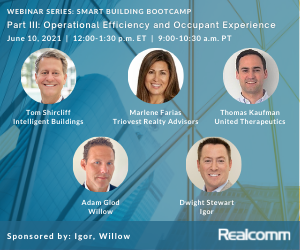The Transformation of the Built Environment Requires a Digital Mindset

Design has always been about creating experiences that matter, rather than just aesthetics. As designers, we have the opportunity to deliver meaningful solutions for complex human challenges.
If 2020 has taught us anything, it’s that we need design more than ever. We are in the midst of a global health crisis that has upended our lives and our economic stability. Issues of social justice and equity are at the forefront of everyone’s mind. And the need for climate action is at an urgent and critical inflection point.
In the face of these major, multifaceted, simultaneous shifts, new ideas and solutions are in high demand. Innovative thinking, fueled by design and technological advancements, has never been more pertinent.
The hybrid future of the built environment
With more than two billion people expected to move to global cities by 2050, the demand for new buildings – and the energy to build and operate them – will continue to rise. If we want to create more livable, inclusive, and resilient cities, the building sector needs to rapidly decarbonize and we need to design spaces that are open, equitable, and safe. As designers, planners, and architects, we have an opportunity – and a responsibility – to tackle these challenges through new and innovative thinking.
But first we have to recognize that the built environment has evolved. When we think about buildings, we can’t just think about geometry. We must consider how pervasive digital technologies have become, and how quickly they are integrating with our physical spaces. Since the pandemic began, we’ve seen an influx in telehealth visits and remote diagnostics; a surge of remote work and virtual collaboration and learning tools and rapid adoption of curbside pickup, contactless delivery, and mobile payments. We’ve also seen rapid advancements in sensor technology and artificial intelligence, both of which allow us to measure how people use space and how they feel about those spaces. All these trends are likely to continue well after the current crisis ends.
As our physical and digital behaviors continue to converge, design for the built environment will require not just advanced technology, but an entirely new digital mindset – a mindset that we’ve been thrust into because of the coronavirus. The COVID-19 pandemic has accelerated our thinking, behaviors, and our interactions with space by about 7-10 years. Digitization has not only accelerated; it has become far more integrated into every facet of our lives. We can no longer rely on past models, definitions, or approaches for planning and design.
What digital-physical convergence looks like
So, what does this mean for the future of the built environment?
For one, our new reality means that buildings need to be designed as multisensory ecosystems with a digital first mindset. For most things we do, no matter where we are, there will be a digital interface that stiches our experience of a place together and creates a gateway to new types of engagement. Many parts of our lives have already become digital first. For buildings and physical spaces to follow suit, we have to rethink journeys, behaviors, and interactions with a digital mindset.
Second, we have to embrace the opportunity that comes with spatial analytics and advanced data intelligence. A built environment that is wired with ambient sensors and systems can harness data about how people move, and how they feel about and engage with spaces. That in turn will allow us to access new learning, experiment with space, and design buildings that are more adaptive, responsive, and resilient. To create new kinds of convergent experiences we must plan and design the physical and digital interactions together.
Third, we must design for engagement.
Designing for engagement
Engagement is key to successful design. Through digital interactions, we can enhance the human experience in the built environment – unlocking potential for greater engagement between people and space . By capturing and analyzing data, we can discover new design solutions using technology to respond to what people want more eloquently and in more personalized ways. The result is a hybrid infrastructure that is reliable, scalable, and adaptive.
Take the new hybrid workplace. People are now expecting more flexibility in when and how they work, as well as systems to support remote participation and workflow. Virtual concierge services, remote participation, and augmented reality wayfinding can help employees better navigate and experience a frictionless workplace through their mobile interface – no matter where they are. And companies can use digital tools to build culture and connection to help distributed workforces thrive.
Another example is the hybrid retail experience. Intelligent personalization – including dynamic customer profiles, tailored recommendations, and self-checkout – can create a bespoke retail experience and enable a higher level of value.
Similarly, digital transformation has the potential to redefine the fan experience. By integrating personalized digital services and amenities, on-demand media, mobile wayfinding, and gamified experiences into sports stadiums, teams and venue owners can empower fans with an omni-channel experience that enables new connections and builds brand loyalty.
What’s next
As designers, we’re getting used to leveraging data, AI and spatial intelligence to better understand the rapidly evolving relationship between human behavior and the design of space. And we’re working on new types of interactions to help people better engage with their environments, including biometrics, voice, and gestures.
Through these advancements, we can provide more value to the experiences we create for people, customers and our clients’ real estate assets, across industries.
Yet, to get to where we want to go, we must aim beyond the holistic design of space and get inspired by the greater purpose of design in responding to the events that have been brought to the forefront this year:
- Designing for (global) health – Digital transformation has the potential to revolutionize healthcare. Telemedicine, for example, will make healthcare more personalized, inclusive, compassionate, and effective. With telehealth, patients can access more care, more easily in the comfort of their own homes.
- Designing for equity – The pandemic, coupled with social unrest, has highlighted inequities and injustice in our society. Through digital technology and services, we have an opportunity to close the digital divide and advance equity to create more inclusive, equitable experiences.
- Designing for climate change – We can leverage data and technology to advance carbon-neutral solutions. For example, by gathering intelligence on carbon metrics, standards, targets, and performance, we can model carbon at all levels of the built environment to better predict and manage climate outcomes.
The disruption that this year has brought to our daily lives has forced us to look for new answers that could alter our collective trajectory. Our opportunity isn’t to look for a quick fix, but to alter our long-term behaviors and approach to design. Paying special focus to the overarching challenges of health, equity, and climate action, the next great wave of design will be the outcome if we choose to see 2020 not as the year where our lives got disrupted, but where we transformed life as we know it.
To learn more about digital experience design, watch the Design Forecast 2021 webinar.
Hans Neubert was also a recent guest at Realcomm Live where shared his thoughts on the integration of physical and digital design for the built environment.
NOTE: This article originally appeared on Gensler Dialogue and is reprinted with permission by Gensler.
This Week’s Sponsor
Locatee is the leading workplace analytics solution that transforms complex data into space utilization insight. Developed with a strong focus and a deep understanding of the corporate real estate challenges facing the modern world of work, Locatee empowers leaders and managers to make decisions about their business buildings with confidence.
Read Next
 5/29/2025
5/29/2025
AI Can’t Fix Bad Data. These Ideas Can Get You on the Right Track. Real estate visionaries constantly integrate innovative technology to make their organizations more efficient.
 5/22/2025
5/22/2025
Managing Building Automation and Integration Like an Investment Portfolio What if your building automation and integration decisions were managed with the same precision, discipline, and long-term vision as Warren Buffett’s investment portfolio?
 5/15/2025
5/15/2025
Tech, Talent and Transformation: 2025 Digie Finalists Announced For 27 years, Realcomm has presented the Digie Awards to acknowledge companies, real estate projects, technologies, and individuals that have advanced the commercial real estate industry through the strategic use of technology, automation, and innovation.
 5/15/2025
5/15/2025
Empowering Space Management with Data-Driven Visualization For effective CRE space management, it’s critical to centralize lease data, maximize rental square footage (RSF), improve energy efficiency and reconfigure spaces to meet changing needs.








%20(1)%20(1)%20(1).png)




